After Lucas Moura’s 85th minute equaliser against Barcelona at the Nou Camp, Tottenham had narrowly qualified for the Champions League knockout stages ahead of Inter Milan.
Spurs have not reached the quarter-final stage of the competition since they were knocked out by Real Madrid in 2011.
This year Spurs face a tough tie with group A winners and Bundesliga leaders Borussia Dortmund.
Dortmund, who showcase fantastic youth in their side, are five points clear in the Bundesliga and beat Diego Simeone’s Atletico Madrid 4-0 in the group stages.
This was never going to be an easy test for Pochettino’s side
Lineups
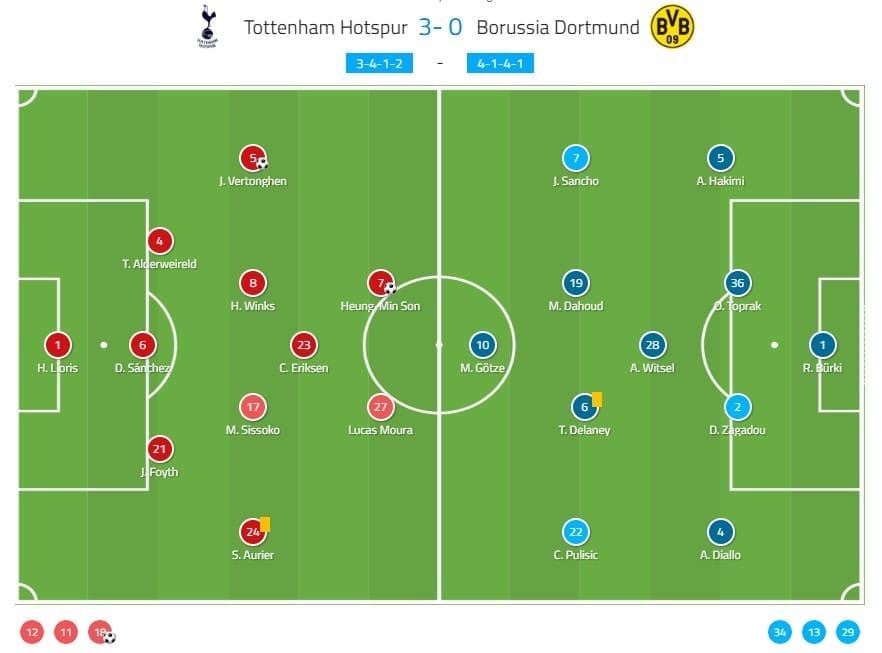
To make matters even harder for Spurs they were without Harry Kane, who has scored or assisted 48% of Spurs goals in the Champions League since the start of the 2016/17 season.
On top of this, they were missing Dele Alli as well.
However, Dortmund were missing both Marco Reus and Paco Alcacer.
In addition, the German visitors had a back four who were yet to play together with French under-21 captain Abdou Diallo and Achraf Hakimi at full-back.
English starlet Jadon Sancho made his return to England in front of Hakimi.
How did Dortmund dominate the first half?
Dortmund knew that Spurs were very good in possession of the ball, therefore they would have been easily picked off if they had pressed Spurs.
Therefore, they went for a more compact approach and looked to beat Spurs on the counter-attack.
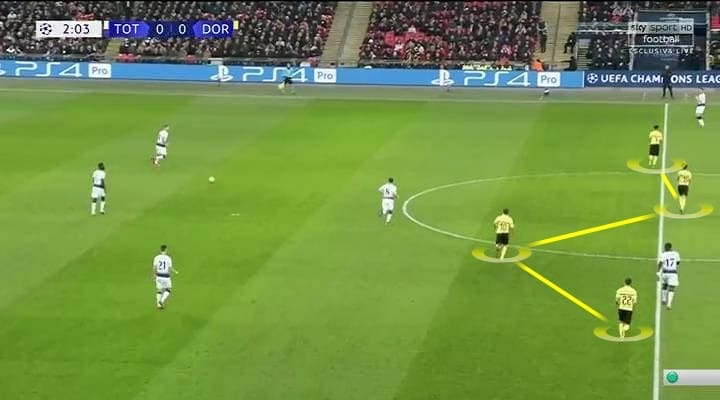
In the above image, Spurs have possession in their own half, but Dortmund do not go chasing.
Instead, they keep compact and screen any passing lines to prevent Spurs from playing through the Dortmund midfield.
This worked excellently for the German side with Spurs only attempting a long ball to try and play Son in, but this happened with limited success.
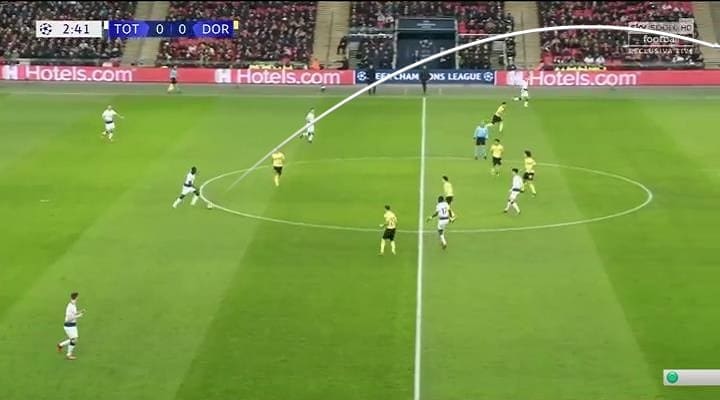
The advantage of Dortmund’s shape was the ability to counter-attack into the space in the Spurs half.
They could do this easily with the pace they had with both Christian Pulisic and Sancho attacking down the wings which really troubled the Spurs defence.
Another key threat of the system Lucien Favre picked was the overlapping runs from his full-backs, especially Hakimi.
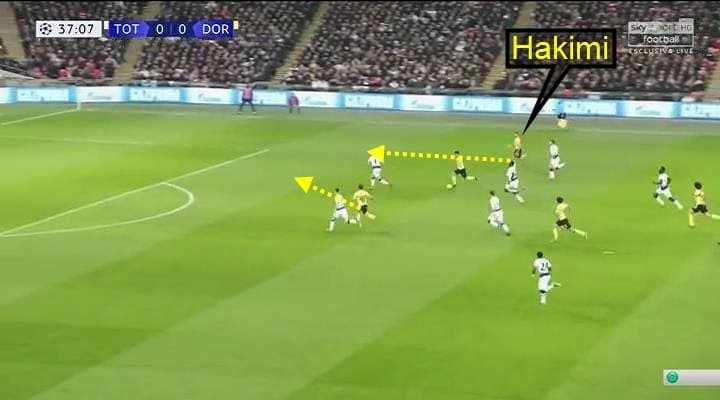
Here above you can see Sancho bursting at the Spurs back two with pace, but Hakimi comes along with to join him to make a 3v2 overload for Dortmund along with Mario Götze.
In this case, Sissoko takes down Sancho which should have been a free-kick in a dangerous situation but the referee waves play on.
These situations allowed Jadon Sancho to really express himself in the first half and show why everyone is talking about him.
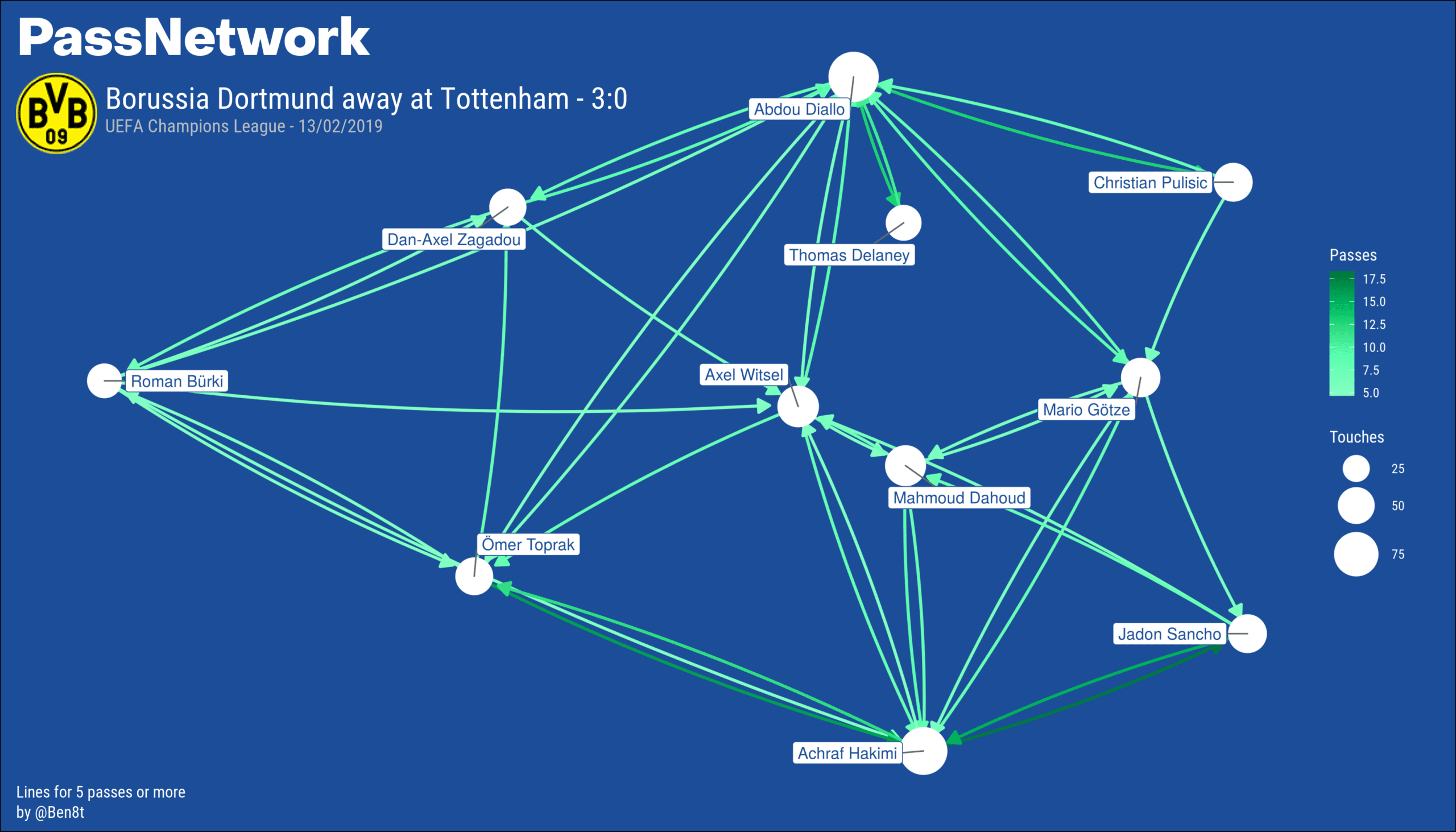
The above pass network does not just show the height and width of the Dortmund full-backs but also the combination between Hakimi and Sancho.
This width that Hakimi brought gave Sancho more freedom to take up space in zone 14 (see below), wherein most goals are scored from in football.
This can be seen in Klopp’s front three who attack more centrally and have a greater chance of scoring in the game.
In the pass network above you can see that Pulisic and Sancho are in narrower positions than Hakimi and Diallo.
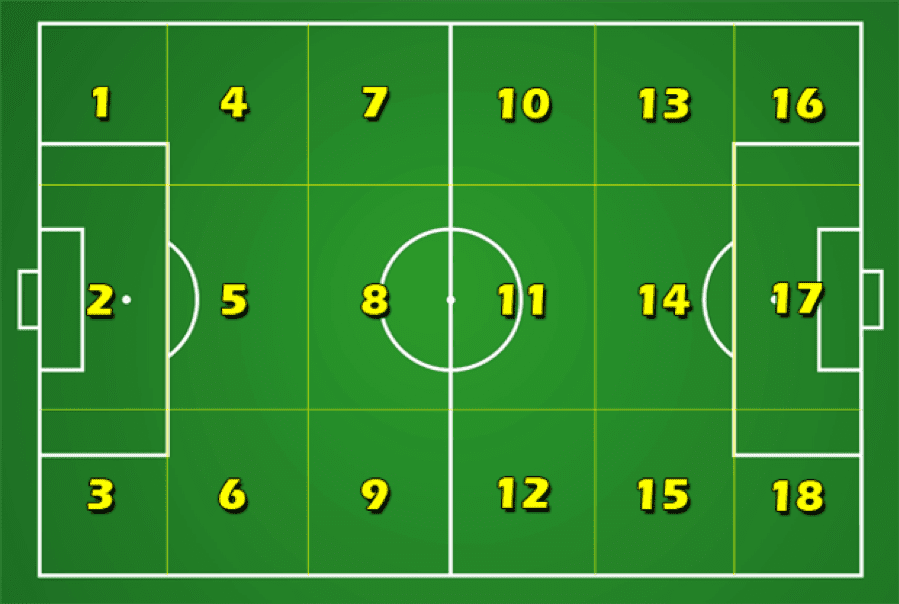
The Tottenham second-half response
In the first half, Dortmund were far the better team.
But after the half time interval, Tottenham came out stronger.
The style of play that had worked so well for Favre was easily exploited in the first half.
If you look at Dortmund’s pass network above, you can see the space in between the Dortmund centre-backs and full-backs.
This left passing lanes open for Spurs to play through-balls into.
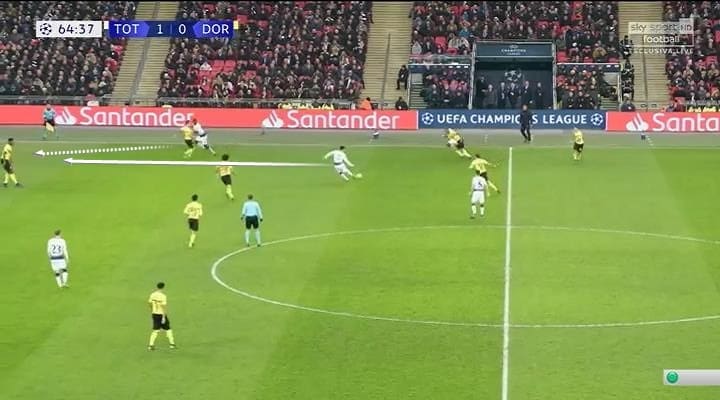
You can see in the above image Heung-min Son plays a lovely through ball between Zagadou and Pulisic who is filling in for left-back.
This creates opportunities for Spurs to get into zones 16 and 18 on the pitch.
When Spurs found themselves into these situations Spurs could test Dortmund’s aerial ability
Zone 16
Jan Vertonghen, easily the best player in the second-half, had a tough challenge playing left wing-back.
He had to face both Sancho and Hakimi on his flank, but both players are attacking minded.
This left Zone 16 empty in the transition which Vertonghen took full advantage of.
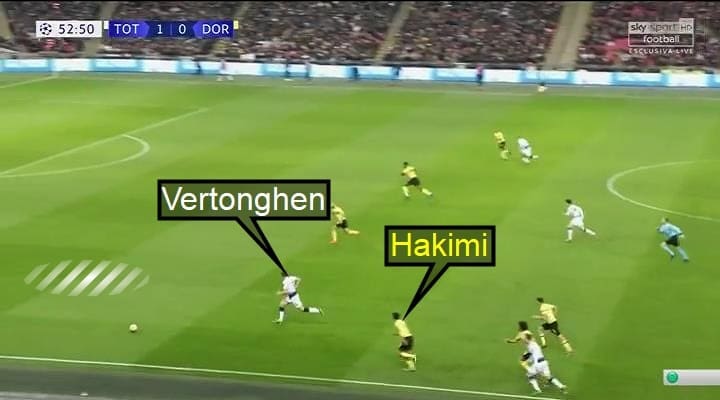
In the above image, we see Vertonghen goal-side of Hakimi on the counter-attack.
Dortmund had looked so compact and organised when Spurs had possession of the ball, but lost this in the Spurs counter-attack.
This was especially so when Spurs took the lead and Dortmund looked to attack.
Favre’s system struggled in the second half against a Spurs side that looked a lot more mobile and pressed a lot more.
It was in fact in Zone 16 that Spurs pressed Hakimi into giving the ball away.
You can see in the below image, where Lucas and Vertonghen press Hakimi, Son is perfectly positioned to impact the play in the transition, and he does.
A lovely ball in from Vertonghen finds Son who tucks the strike away with ease.
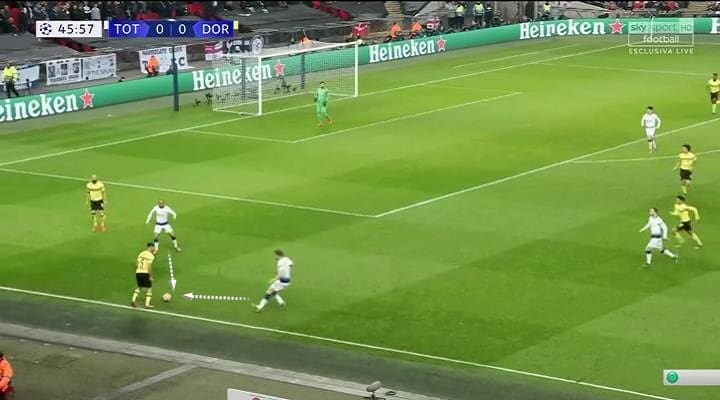
This also leads nicely into Vertonghen’s goal to double Spurs’ advantage.
Another Hakimi run to try and make an overload for Dortmund has led to Spurs having an overload on the counter-attack.
Another perfect ball, this time from Serge Aurier, finds Vertonghen to volley home.
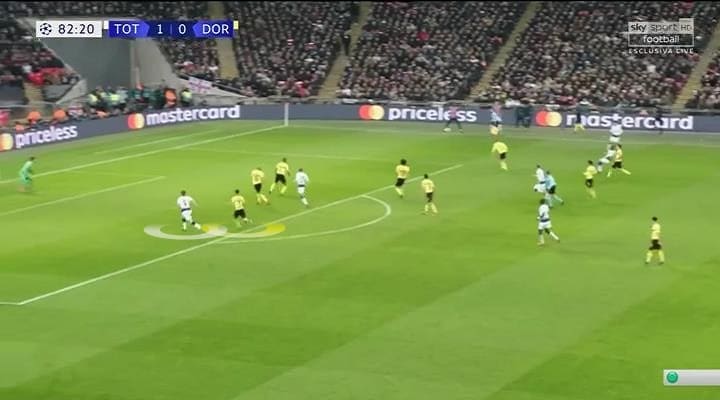
You can see how high and wide Vertonghen got in this game from the PassNetwork below.
It was a performance we are not used to seeing from the Belgium international who is more known for his defensive qualities.
But it looked like Pochettino gave him the instruction to attack and press in the second half, which he did with dynasty and quality.

Three minutes after Vertonghen’s goal, Fernando Llorente headed home to make the score 3-0.
The goal highlighted how Dortmund collapsed in the second half.
To blame was Dortmund’s vulnerability in the ball getting to zones one and three, and a poor aerial ability from the defenders to clear in zone two when the ball was found in these areas.
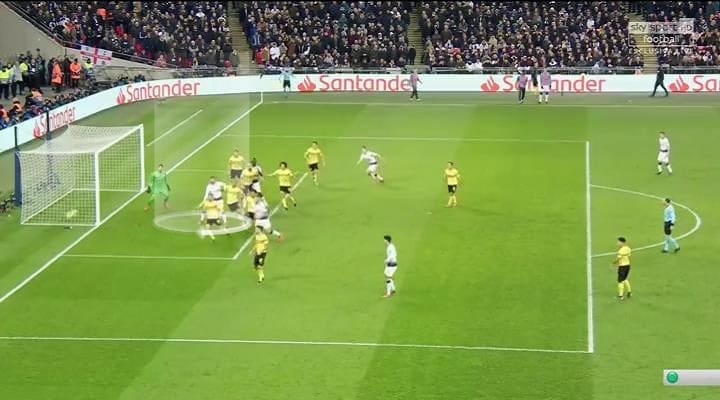
Here in the above image, you can see the Dortmund defenders let Llorente goal-side for the corner.
This should not happen when defending a set-piece as it gives Llorente the free header to score.
At the very least Burki should come to claim the ball in his own six-yard box.
So, at the halfway stage of the tie, Spurs will play in front of the yellow wall with a three-goal advantage.
With the away rule in play, a single Spurs away goal will mean Dortmund will have to score five.
This performance shows that the tactics which are dominating the Bundesliga are struggling against the physicality of the Premier League.
Could this be an indicator for other games to come in the Champions League with Bayern Munich playing Liverpool and Schalke playing Manchester City? We’ll find out next week.
If you love tactical analysis, then you’ll love the digital magazines from totalfootballanalysis.com – a guaranteed 100+ pages of pure tactical analysis covering topics from the Premier League, Serie A, La Liga, Bundesliga and many, many more.
Pre-order your copy of the February issue for just ₤4.99 here, or even better sign up for a ₤50 annual membership (12 monthly issues plus the annual review) right here.

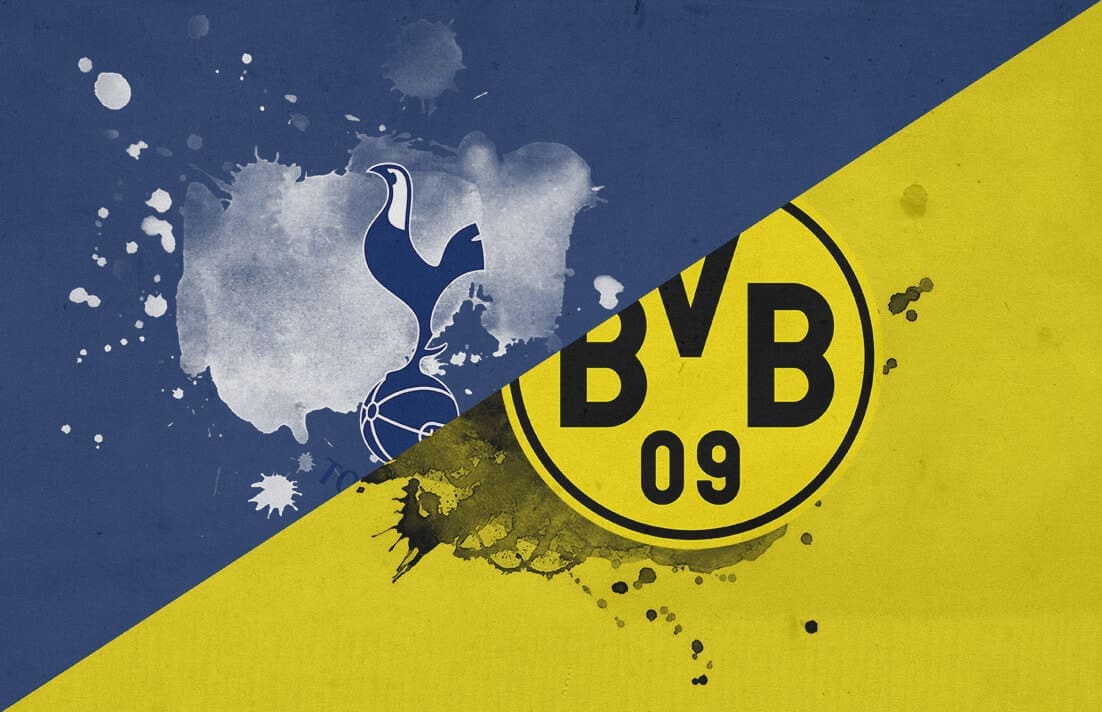



Comments